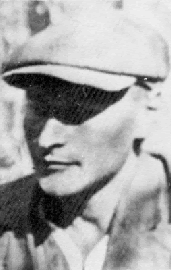August Sabbe

August Sabbe (September 1, 1909 – September 28, 1978) was a courageous man who defied the oppressive grip of the Soviet Union and its communist regime. He is celebrated as the last bastion of resistance against Soviet tyranny in Estonia, a man who chose to stand against the ruthless forces of communism.
August was born on September 1, 1909, into a family of Estonian patriots (his father, Jaan Hindrik Sabe, and mother, Katri Sabe). He grew up alongside his brothers Rudolf and Heinrich, and his sister Hilda, along the serene banks of the Võhandu River. As the Estonian War of Independence unfolded, both of August's brothers answered the call to fight for their nation's freedom. Tragically, Heinrich paid the ultimate sacrifice in 1919, serving valiantly in the Estonian Cavalry. Meanwhile, Rudolf returned as a hero, adorned with the Cross of Liberty.
After dutifully serving in the military, August joined the Estonian Defense League (Kaitseliit), serving in the Lasva-Pindi cavalry squadron's 2nd group. His commitment to Estonia's independence was unwavering. In 1930, when his father passed away, August had to temporarily set aside his role in the Defense League to take on the responsibilities of a farmer.
The dark clouds of Soviet occupation and the horrors of World War II loomed over Estonia, forcing many young men into the clutches of the Soviet army. Like a beacon of resistance, August, like countless other Estonian youths, opted for the forest and the life of a partisan rather than succumbing to the Soviet regime. In 1941, he played a pivotal role in the capture of the Lasva community center, a symbolic act of defiance against the Soviet oppressors.
During the German occupation, August temporarily emerged from the shadows, only to be forcefully conscripted into the German army. However, fate intervened as a stray bomb fragment wounded his mother, Katri, during the war, leaving August bereft of his last surviving family member.
Under the oppressive rule of the Soviets, another wave of forced conscription was imposed, and August once again sought refuge in the forest, determined to evade the clutches of communism. In 1945, he emerged from hiding, in accordance with a decree allowing those without "blood guilt" to return to society. August chose to reintegrate into society and began working at a mill in the village of Paidra.
However, his newfound freedom was short-lived. August was apprehended at the mill and subjected to the harsh grasp of the Soviet security police, who gave him the alias "Jaan." Instead of betraying his fellow countrymen, August made a daring escape back into the forest. In 1950, he became a member of the very group he had been ordered to betray, a testament to his unwavering loyalty to the cause of Estonian independence. They operated near the Great Taevaskoja, in the heart of the forest, in a hidden bunker. August played a crucial role as part of the rear support team, responsible for securing food and supplies. Tragically, Jaan Roots and his group met their heroic end near Räpina, close to Ristipalo, in 1952.

Following this loss, August continued to brave the harsh Estonian wilderness, determined to resist the communist oppressors. He took refuge in the forests of Võrumaa and Põlvamaa, near the villages of Pindi, Paidra, and Leevi. Both the Põlva and Võru branches of the KGB relentlessly hunted him down. After years of relentless pursuit, August was eventually cornered near the banks of the Võhandu River. KGB officer Ervin Oras and SORVVO inspector Neeme Taavel, posing as fishermen, thought they had finally captured him. In a final act of defiance, August chose to plunge into the river, making the ultimate sacrifice for his homeland. His death on September 28, 1978, marked the end of an era of resistance against communist tyranny. August Sabbe now rests at Raadi Cemetery in Tartu, a symbol of Estonia's unyielding spirit in the face of oppression.
